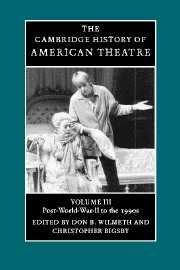Book contents
- Frontmatter
- Introduction
- Timeline: Post-World War II to 1998
- 1 American Theatre in Context: 1945–Present
- 2 A Changing Theatre: Broadway to the Regions
- 3 The Plays and Playwrights
- 4 Musical Theatre since World War II
- 5 Directors and Direction
- 6 Actors and Acting
- 7 American Theatre Design Since 1945
- Bibliography
- Index
7 - American Theatre Design Since 1945
Published online by Cambridge University Press: 28 March 2008
- Frontmatter
- Introduction
- Timeline: Post-World War II to 1998
- 1 American Theatre in Context: 1945–Present
- 2 A Changing Theatre: Broadway to the Regions
- 3 The Plays and Playwrights
- 4 Musical Theatre since World War II
- 5 Directors and Direction
- 6 Actors and Acting
- 7 American Theatre Design Since 1945
- Bibliography
- Index
Summary
Introduction
The history of contemporary American theatre design, that is, the design of scenery, costumes, and lighting in the United States after World War II, can actually be traced back to the 1915 production of The Man Who Married a Dumb Wife, directed by British director Harley Granville-Barker and designed by Robert Edmond Jones (see Volume 2, Chapter 8 for a discussion of this event and its context). Jones’s flat, monochromatic set presented a stark contrast to the popular, realistic productions produced by David Belasco, and it is often cited as the first important domestic example of what would eventually be known as the New Stagecraft, which some recent scholars and critics have claimed to be the most significant development in twentieth-century American theatre.
In comparison to “Belascan realism,” the New Stagecraft presented a “simplified realism.” Primarily inspired by Edward Gordon Craig and Adolphe Appia, it promoted a visual stage picture that often bordered on the abstract. European designers associated with the New Stagecraft style included Max Reinhardt, Oskar Strnad, Georg Fuchs, and Joseph Urban, who began his American career working at the Boston Opera in 1912. In the United States, Samuel Hume’s 1914 exhibition of new designs from Europe (seen in Boston, New York, Detroit, Chicago, and Cleveland), Boston’s Toy Theatre, Chicago’s Little Theatre, and the design work of Livingston Platt also played an important part in introducing this style to American production.
While The Man Who Married a Dumb Wife occupies a critical position in the history of American theatre design, it was Jones’s other designs – for The Devil’s Garden, directed by Arthur Hopkins in 1915; for the John Barrymore Shakespeare productions (also directed by Hopkins) during the following decade; and his work on the major plays of Eugene O’Neill for the Provincetown Players – that actually popularized the New Stagecraft.
- Type
- Chapter
- Information
- The Cambridge History of American Theatre , pp. 514 - 533Publisher: Cambridge University PressPrint publication year: 2000
- 1
- Cited by



